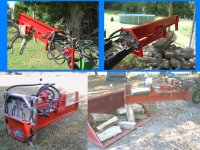You are using an out of date browser. It may not display this or other websites correctly.
You should upgrade or use an alternative browser.
You should upgrade or use an alternative browser.
Log Splitter
- Thread starter hogi
- Start date
- Views: 10098
More options
Who Replied?
/ Log Splitter
#21
I think your log splitter is the neatest i've seen. In your other posts about your log splitter do you give the deminsions for the i-beam (width, length, hieght, thickness of the material sort of thing).stray said:Just wanted to throw in these pics. I sure you can make some improvements on this one. Might give you some ideas though.
ldabe
Gold Member
stray said:Just wanted to throw in these pics. I sure you can make some improvements on this one. Might give you some ideas though.
Stray,
I don't know much about hydraulics, but I was wondering (for the price, $69.99) could this 'Harborfreight Log Splitter' be adapted to use with the PT:
http://www.harborfreightusa.com/usa/itemdisplay/displayItem.do?itemid=39981
"CENTRAL HYDRAULICS"
TWO SPEED, 10 TON HYDRAULIC LOG SPLITTER
'Quick log splitting at an affordable price. Manually operated, two speed pump builds up to 10 tons of log-splitting pressure fast. Pump is operated by two 29-1/2'' steel handles. Includes pressure release valve.
Heavy duty spring return
Accepts up to 18-1/2'' long logs
Accepts up to 6-1/2'' diameter logs'
I have a small wood burning stove and some of the wood I purchase is all ready split, but some of it I would like to spit even further.
Thanks in advance for your time and info, and great job on your splitter.
Abe.
stray
Platinum Member
- Joined
- Jan 18, 2004
- Messages
- 709
- Location
- east TN
- Tractor
- Power-trac 422 2003 model and 428 January 2015 model
Yes, with a different cylinder of that size with pipe connections. With one that size you could use the quick attach Hyd system (the small connections not the PTO) and obtain a satisfactory speed. You may or may not like the size limit of the wood it will split. But it would be cheep and a good project to introduce you the concept.
Quick connect hook ups deliver about 3 gal per minute.
PTO connect hook ups deliver about 8 gal per minute.
Quick connect hook ups deliver about 3 gal per minute.
PTO connect hook ups deliver about 8 gal per minute.
J_J
Super Star Member
- Joined
- Sep 6, 2003
- Messages
- 18,973
- Location
- JACKSONVILLE, FL
- Tractor
- Power-Trac 1445, KUBOTA B-9200HST
ldabe said:Stray,
I don't know much about hydraulics, but I was wondering (for the price, $69.99) could this 'Harborfreight Log Splitter' be adapted to use with the PT:
http://www.harborfreightusa.com/usa/itemdisplay/displayItem.do?itemid=39981
"CENTRAL HYDRAULICS"
TWO SPEED, 10 TON HYDRAULIC LOG SPLITTER
'Quick log splitting at an affordable price. Manually operated, two speed pump builds up to 10 tons of log-splitting pressure fast. Pump is operated by two 29-1/2'' steel handles. Includes pressure release valve.
Heavy duty spring return
Accepts up to 18-1/2'' long logs
Accepts up to 6-1/2'' diameter logs'
I have a small wood burning stove and some of the wood I purchase is all ready split, but some of it I would like to spit even further.
Thanks in advance for your time and info, and great job on your splitter.
Abe.
I think you would be disappointed with that small unit. Stray has one built for his machine. I have one of the Northern Tools PT units that is driven off the rear hyd circuit of my Kubota. The log splitter from Northern Tools, comes almost ready to install. You would have to put a mounting bracket on it, and plug in the hydraulics. This unit will handle 24 in logs. If you have the capabilities, you could round up all the parts, and save a little money. If you can find a gas driven log splitter, that has a blown the engine, you could probably get it cheap.
MossRoad
Super Moderator
- Joined
- Aug 31, 2001
- Messages
- 66,099
- Location
- South Bend, Indiana (near)
- Tractor
- Power Trac PT425 2001 Model Year
Something like this from Northern Tool would be just about ready to go out of the box. Just add some hoses and you could run it on the ground, or add a quick attach plate.
ldabe
Gold Member
Man! You guys are good!
It never ceases to amaze me on the knowledge of this forum. And quick too!!
Thanks fellas, I think you covered all the bases and gave me plenty to think about (now all I need is some time and money).
These guys are good, real good...[walks off in amazement, shaking head with huge smile on face, muttering under his breath with wife staring over top of glasses and thoughts of guys in white coats showing up at front door].
It never ceases to amaze me on the knowledge of this forum. And quick too!!
Thanks fellas, I think you covered all the bases and gave me plenty to think about (now all I need is some time and money).
These guys are good, real good...[walks off in amazement, shaking head with huge smile on face, muttering under his breath with wife staring over top of glasses and thoughts of guys in white coats showing up at front door].
